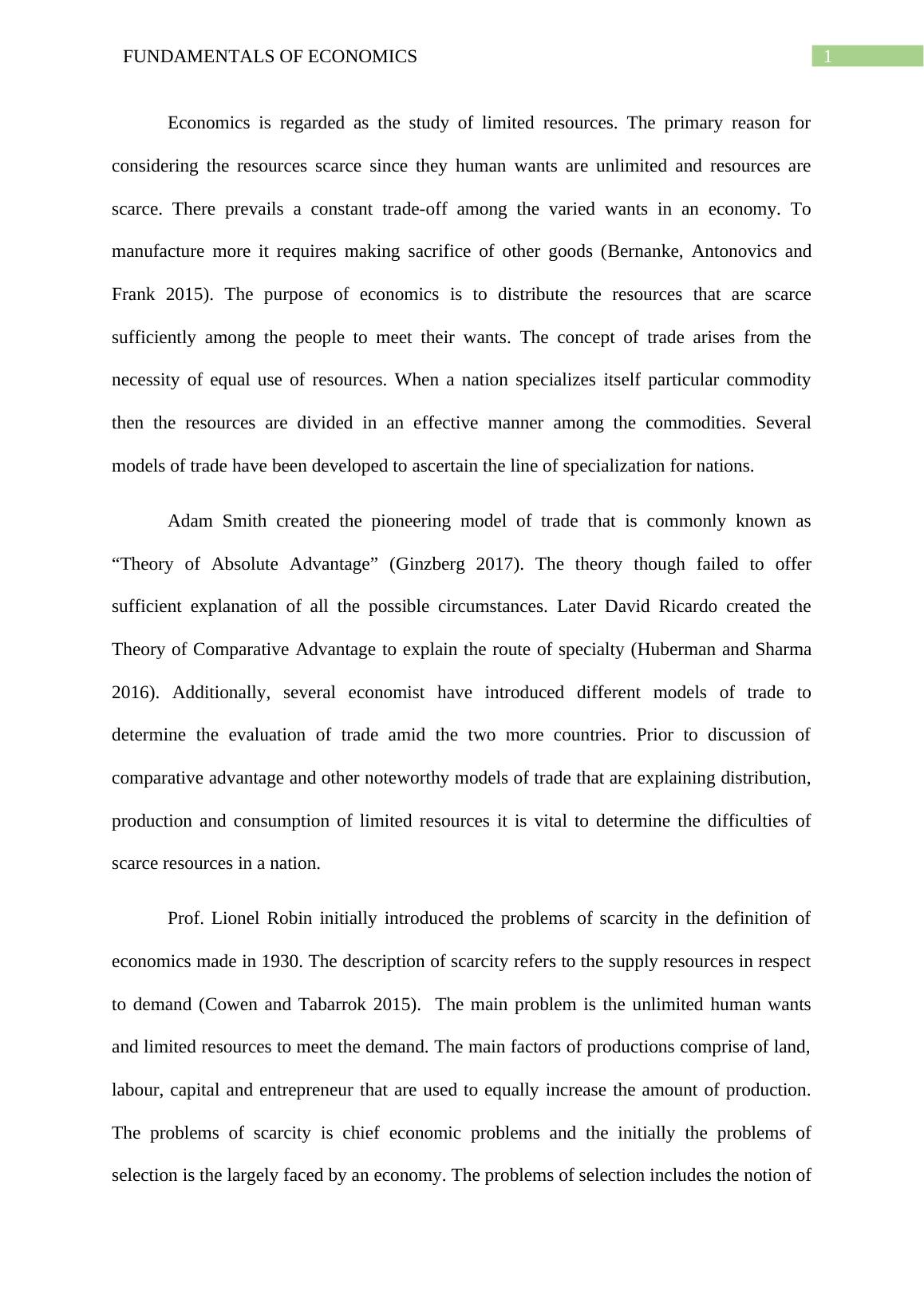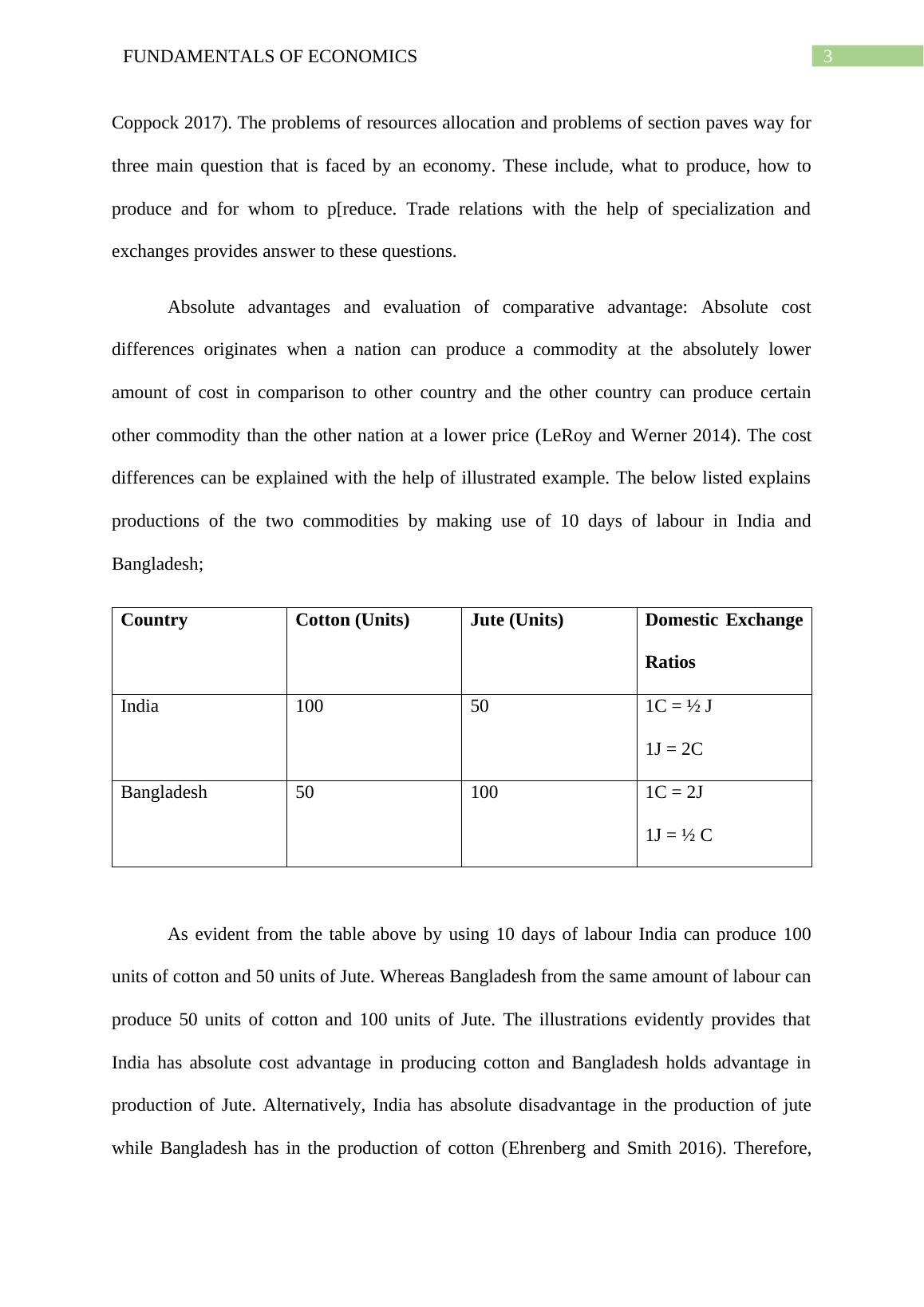Fundamentals of economics assignment
Added on 2021-04-17
12 Pages2348 Words33 Views
Running head: FUNDAMENTALS OF ECONOMICSFundamentals of EconomicsName of the StudentName of the UniversityAuthors NoteCourse ID

FUNDAMENTALS OF ECONOMICS1Economics is regarded as the study of limited resources. The primary reason forconsidering the resources scarce since they human wants are unlimited and resources arescarce. There prevails a constant trade-off among the varied wants in an economy. Tomanufacture more it requires making sacrifice of other goods (Bernanke, Antonovics andFrank 2015). The purpose of economics is to distribute the resources that are scarcesufficiently among the people to meet their wants. The concept of trade arises from thenecessity of equal use of resources. When a nation specializes itself particular commoditythen the resources are divided in an effective manner among the commodities. Severalmodels of trade have been developed to ascertain the line of specialization for nations. Adam Smith created the pioneering model of trade that is commonly known as“Theory of Absolute Advantage” (Ginzberg 2017). The theory though failed to offersufficient explanation of all the possible circumstances. Later David Ricardo created theTheory of Comparative Advantage to explain the route of specialty (Huberman and Sharma2016). Additionally, several economist have introduced different models of trade todetermine the evaluation of trade amid the two more countries. Prior to discussion ofcomparative advantage and other noteworthy models of trade that are explaining distribution,production and consumption of limited resources it is vital to determine the difficulties ofscarce resources in a nation. Prof. Lionel Robin initially introduced the problems of scarcity in the definition ofeconomics made in 1930. The description of scarcity refers to the supply resources in respectto demand (Cowen and Tabarrok 2015). The main problem is the unlimited human wantsand limited resources to meet the demand. The main factors of productions comprise of land,labour, capital and entrepreneur that are used to equally increase the amount of production.The problems of scarcity is chief economic problems and the initially the problems ofselection is the largely faced by an economy. The problems of selection includes the notion of

FUNDAMENTALS OF ECONOMICS2opportunity cost. The opportunity on the other hand refers to sacrifice of income to obtain thenext best alternative. In an economy labour faces the difficulties amid the labour intensivechoices. Increased work efforts results in increased income but requires making sacrifice ofleisureliness. The opportunity of cost and problems of selection is relevant in nations duringresources allocation and varied production choices. For a better understanding, the theory ofproduction possibility curve is studied to reflect the production boundary of a country. Figure 1: Production Possibility Curve (Source: Sunley 2017)As evident from the above stated figure production increase in production of oneproduct requires reducing the production of other goods. The production possibility curveassumes the concept that a nation can produce two goods from all their resources (Mateer and

FUNDAMENTALS OF ECONOMICS3Coppock 2017). The problems of resources allocation and problems of section paves way forthree main question that is faced by an economy. These include, what to produce, how toproduce and for whom to p[reduce. Trade relations with the help of specialization andexchanges provides answer to these questions. Absolute advantages and evaluation of comparative advantage: Absolute costdifferences originates when a nation can produce a commodity at the absolutely loweramount of cost in comparison to other country and the other country can produce certainother commodity than the other nation at a lower price (LeRoy and Werner 2014). The costdifferences can be explained with the help of illustrated example. The below listed explainsproductions of the two commodities by making use of 10 days of labour in India andBangladesh; Country Cotton (Units)Jute (Units)Domestic ExchangeRatiosIndia 100501C = ½ J 1J = 2CBangladesh 501001C = 2J 1J = ½ CAs evident from the table above by using 10 days of labour India can produce 100units of cotton and 50 units of Jute. Whereas Bangladesh from the same amount of labour canproduce 50 units of cotton and 100 units of Jute. The illustrations evidently provides thatIndia has absolute cost advantage in producing cotton and Bangladesh holds advantage inproduction of Jute. Alternatively, India has absolute disadvantage in the production of jutewhile Bangladesh has in the production of cotton (Ehrenberg and Smith 2016). Therefore,both the nations would gain if they specialize in their respective goods and exchange thecommodities of each other.

End of preview
Want to access all the pages? Upload your documents or become a member.
Related Documents
Assignment on Fundamentals of Economics (pdf)lg...
|12
|2833
|374
Fundamentals of Economics PDFlg...
|11
|2464
|33
ECO10250 - Economics For Decision Making SCUlg...
|13
|2040
|45
Economics Name of the University Author Notelg...
|14
|1907
|409
Introduction to Economics: Fundamental Problems, Scarcity, Opportunity Cost, and Demandlg...
|6
|829
|312
The Scarcity Principle and Its Implicationslg...
|5
|753
|458
